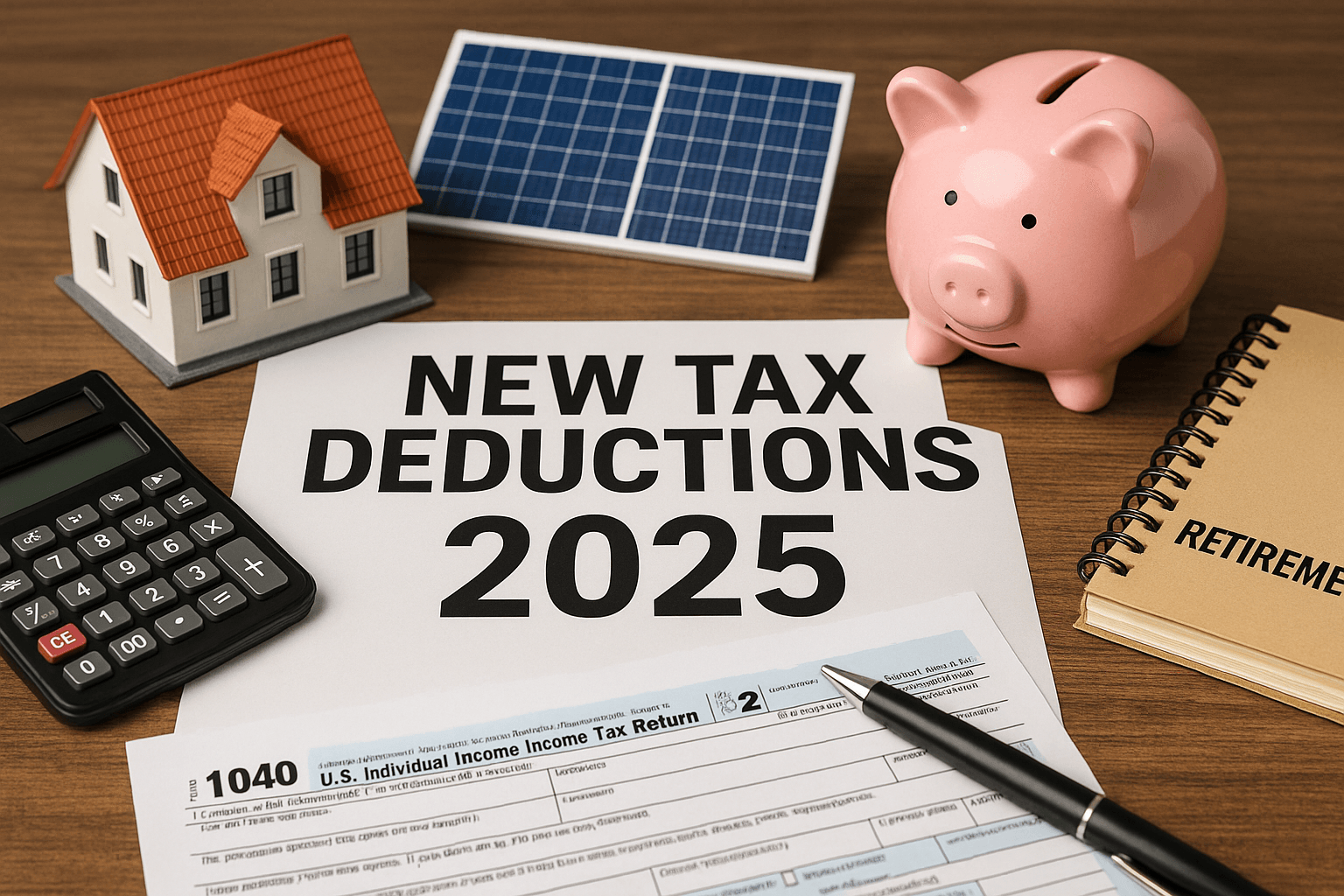
Unlocking Fresh Tax Savings: Your 2025–2026 Deduction Playbook
Alex Howard
5-8 Minutes min read • Oct 27, 2025
Unlocking Fresh Tax Savings: Your 2025–2026 Deduction Playbook
As the tax landscape shifts dramatically for 2025 and beyond, proactive business owners, high-earning professionals, and savvy savers have new opportunities to shelter income, accelerate write-offs, and lower tax bills. In this guide, we’ll walk through four game-changing federal tax breaks—from the One Big Beautiful Bill Act’s below-the-line deductions to supercharged retirement catch-ups, clean-energy home credits, and beefed-up business expensing. You’ll finish with clear action items to capture every dollar of savings before year’s end.
1. The One Big Beautiful Bill Act’s “Below-the-Line” Deductions
Traditionally, most deductions reduce your adjusted gross income (AGI). OBBBA flips the script: four below-the-line breaks directly shrink taxable income, so even standard-deduction filers win.
- Tip Income Deduction
- What it is: Up to $25,000 of qualified tip income per taxpayer, regardless of filing status.
- Why it matters: Service-industry business owners and high-tipped employees can exclude more tips from taxable income.
- Action item: Track all tip records meticulously; report qualified amounts on Schedule 1.
- Overtime Premium Deduction
- What it is: Deduct the premium portion of time-and-a-half pay—up to $12,500 ($25,000 joint).
- Why it matters: Employers and employees working long hours capture extra savings on that overtime premium.
- Action item: Verify payroll systems separate base pay from premiums for clean reporting.
- New-Vehicle Loan Interest
- What it is: Up to $10,000 interest deduction on loans for new vehicles purchased after 2024.
- Why it matters: High-mileage business drivers can finance new EVs or light trucks and deduct interest beyond the standard business-vehicle limits.
- Action item: Confirm “new” status and loan terms; allocate business vs. personal miles properly.
- Senior Deduction
- What it is: An extra $6,000 deduction for each taxpayer age 65+ (2025 onward).
- Why it matters: Retirees and older entrepreneurs enjoy a larger standard deduction bump—no itemizing required.
- Action item: Mark birthday cutoffs; plan distributions and W-2 income to optimize age thresholds.
2. Supercharged Retirement Savings under SECURE 2.0
The SECURE 2.0 Act cranks up retirement deferrals and catch-up limits for 2025:
- Elective Deferral Increase
- 401(k)/403(b)/457(b) limits rise to $23,500 (up $500).
- IRA contribution phase-outs inch up for higher-income savers.
- “Super Catch-Up” for Ages 60–63
- You can contribute the greater of $10,000 or 150% of the standard catch-up (up to $11,250).
- Ideal for late-career earners looking to turbocharge tax-deferred buckets.
Quick Tip: If you’re turning 60–63 in 2025, adjust payroll elections or IRA contributions before December 31st to snag the full extra amount.
3. Clean-Energy and Home Improvement Credits
The Inflation Reduction Act’s energy incentives got fresh tweaks for 2025:
- Home Improvement Credit (§ 25C)
- Rate: 30% of qualifying envelope improvements (insulation, windows, doors) up to $1,200 per year.
- Heat Pump/Boiler Credit: Separate $2,000 cap for high-efficiency HVAC installations.
- New Requirement: Manufacturer’s PIN authentication on invoices starting 2025.
- Residential Clean Energy Credit (§ 25D)
- Rate: 30% credit for solar panels, wind turbines, geothermal systems, and battery storage through 2032.
- Stackable: Combine with state/local rebates for deeper net savings.
Pro Tip: Lock in quotes and request manufacturer PINs before installation. Delays post-January 1 can cost your credit.
4. Business Owners’ Write-Off Arsenal
Small-business taxpayers and independent contractors have beefier expensing options:
- 100% Bonus Depreciation
- Retroactive permanent extension for first-year write-off on qualifying equipment and software.
- No dollar limit; phase-outs no longer apply.
- Section 179 Expensing
- 2025 Cap: $1,250,000 total expensing, phasing out at $3.13 million of equipment purchases.
- What Qualifies: New and used tangible business property, off-the-shelf software, certain improvements to non-residential real property.
- Full R&D Expensing (§ 174)
- Through 2025, you may fully deduct R&D costs in the year incurred (then amortize over five years thereafter).
- Critical for tech startups, product designers, and process-improvement projects.
Action Item: Conduct an equipment audit by Q4; accelerate planned purchases or software deployments into 2025 to capitalize on these limits.
Key Takeaways & Action Items:
Area:
- OBBBA Deductions
- Action: Validate tip logs, payroll premiums, new-vehicle loans, and age status.
- Deadline / Window: Before filing 2025 return
- Retirement Boosts
- Action: Adjust elective deferrals; maximize super catch-up contributions.
- Deadline/ Window: Dec 31, 2025.
- Home Energy Credits
- Action: Obtain manufacturer PINs on your quotes; schedule installations.
- Deadline/ Window: As soon as possible in 2025.
- Business Expensing
- Action: Audit cap-ex plans; accelerate equipment/software buys.
- Deadline/ Window: Before year-end 2025.
- Review payroll systems for correct premium and tip reporting.
- Update retirement-plan elections via your plan administrator or IRA custodian.
- Gather energy-upgrade quotes with valid PINs and check local incentives.
- Plan Q4 capital expenditures to maximize Section 179 and bonus depreciation.
- Consult your CPA to ensure proper election and filing for each new deduction.
By weaving these new breaks into your year-end tax strategy, you can meaningfully reduce your 2025 tax liability—whether you’re running a business, boosting retirement contributions, or upgrading your home for efficiency. Start planning now to claim every opportunity before the calendar turns!